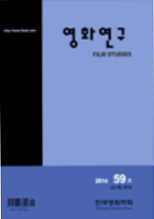- 영문명
- ‘Proposing a New Reading of Film,’ or Formulating a Critical Cinephila: On the Activities of munhwahaggyo-seoul [Cultural Institute Seoul] in the 1990s’ Korean Film Culture
- 발행기관
- 한국영화학회
- 저자명
- 이선주
- 간행물 정보
- 『영화연구』제59호, 223~252쪽, 전체 30쪽
- 주제분류
- 예술체육 > 예술일반
- 파일형태
- 발행일자
- 2014.03.31

국문 초록
영문 초록
This paper chronicles and examines the activities of munhwahaggyoseoul[Cultural Institute Seoul (CIS)], a private cinemathèque that wasfounded in 1992 and built a stronghold of an alternative film culture inthe 1990s’ Korean film, sphere. After its national political liberation,South Korean film culture in the 1990s witnessed the burgeoning ofdedicated film viewing ignited by the foundation of new film magazines(Cine21 for weekly, and KINO for monthly), private cinemathèques,university cine-clubs, and non-university institutions dedicated to theeducation of humanities. In this paper I demonstrate that amongst allthese cultural players, the CIS deserves particular attention in terms of thedevelopment of cinephilia due to its key activities (screening and discussion,education and study teams, and publication) and their underlying ideas. Inso doing, I argue that the CIS’ actitvities in the 1990s were not simply aremarkable attempt to regionalize Henri Langlois’ archetypical cinemathèquein the form of videothèque despite the lack of celluloid, but they signalleda dialectics of love and oblivion, of enchantment and disenchantment, asthe underlying sensibility of Western cinephilia. While the CIS’ regular and special screenings and their accompanieddiscussions were grounded in the auteurist model of cinephilia, other actitivies such as promoting study teams and publishing the outputs oftheir studies exemplified the collective’s extensive interests in introducingmajor tenets of contemporary film theories (psychoanalysis, genre studies)and critical philisophy (postmodernism) and using them to critically rereadthe canons of Western cinema as well as the history of Korean cinema. The latter activities as notable uses of disenchanement, promoted arenewed recognition of cinema in the Korean society of the time in thesense that the theories and critical frameworks offered the devotedspectators the repertoire of the broader questions on cinema—film’sessence, cinema and society, and cinema as a cultural practice—than filmas entertainment. Considering all the activities, I argue that the mostcrucial role of the CIS was to formulate and cultivate critical cinephilia inthe cultural sphere of Korean cinema in the 1990s, a cinephiliac sensiblitymarked by the productive tension between the devoted viewer’sfascination with cinema and her/his critical engagement with it.
목차
1. 들어가며
2. 1990년대 한국 시네필 문화의 특정성
3. 1990년대 ‘문화학교 서울’의 활동들
4. ‘비판적 시네필리아’ 그 이후: 2000년대 이후 시네마테크의 영화문화
키워드
해당간행물 수록 논문
참고문헌
최근 이용한 논문
교보eBook 첫 방문을 환영 합니다!

신규가입 혜택 지급이 완료 되었습니다.
바로 사용 가능한 교보e캐시 1,000원 (유효기간 7일)
지금 바로 교보eBook의 다양한 콘텐츠를 이용해 보세요!


